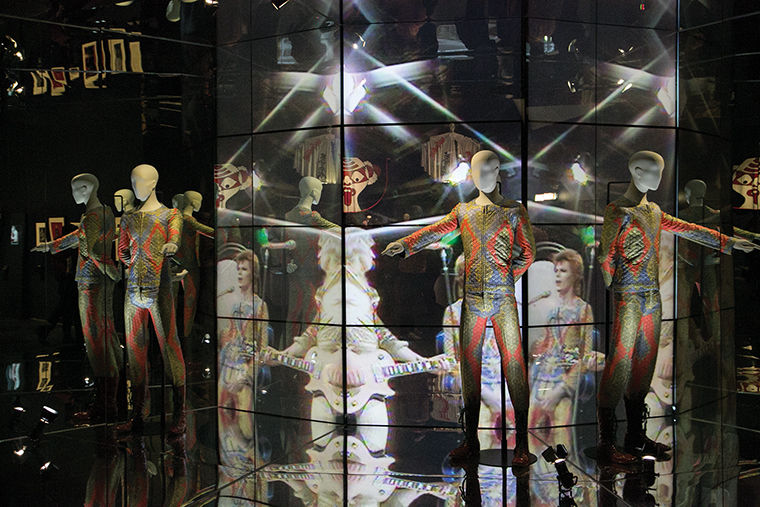David Bowie exhibit ‘really made the grade’ at MCA
David Bowie Is
September 29, 2014
The “David Bowie Is” exhibit opened its doors to the public on Sept. 23 at Chicago’s Museum of Contemporary Art, 220 E. Chicago Ave., beginning the exhibit’s 3-month stop at the only American museum on its tour.
“David Bowie Is” is the first international retrospective of world-renowned English artist and musician David Bowie. The exhibit was curated by Geoffrey Marsh, director of the Department of Theatre & Performance, and Victoria Broackes, head of Exhibitions for the Department for Theatre & Performance, of the Victoria and Albert Museum in London, where the exhibit made its grand premiere in March 2013.
Marsh said in a panel discussion that the exhibit originated when a representative of Bowie’s contacted them after a previous exhibit idea had fallen through.
“It all came about by kind of a series of accidents,” Marsh said. “We were going to do a show about another major—actually, an American—performer, but for various reasons, it didn’t come off. After that, a guy rang us up and said, ‘Are you guys interested in seeing David’s archives?’ I think we looked at it for about 10 seconds and we said, ‘Yes!’”
Marsh said that apart from allowing the curators access to his archives, Bowie did not want anything to do with the production of the exhibit and left it up to Broackes and Marsh to construct it.
“I’ve never spoken with David, [and] I’ve never met him, which is kind of curious,” Marsh said. “But you realize when you get to see how David works, he controls every aspect of what he does, whether it’s recording, composing, designing clothes … so I think he realized that if he did the exhibition, it was going to be [about] him, and he wanted somebody else to do it.”
Marsh also said this exhibit is one of a kind, not only because it is the first international retrospective on Bowie, but also because most musicians of Bowie’s stature have not maintained such an amazing collection as he has. Bowie is a notoriously private person, and Marsh said keeping the collection has allowed him to curate his image.
“Most music stars don’t have collections,” Marsh said. “It’s not very rock ‘n’ roll collecting stuff. So many bands have broken up, people got divorced or their managers run off with everything or the warehouse burned down, so there’s very few people who have collections, and only a handful have anything on this scale.”
Michael Darling, chief curator at the MCA, said the museum became a part of the exhibit’s tour due to its persistent interest in hosting the exhibit earlier on in its existence, and the museum became the only American stop on the tour as a result.
“It was a little bit of ‘the early bird gets the worm,’” Darling said. “So we got in there early, started talking seriously from the beginning, always with the idea that we’d be the first American venue … but once all these other museums from around the world got word, we were left holding the bag as the only American institution.”
David Buckley, an author and long-time Bowie fan, has written two books on the artist, including a biography titled, “Strange Fascination: David Bowie: The Definitive Story.” He said he visited the exhibit at the Victoria and Albert Museum in London and was fascinated by the encompassing collection of Bowie’s work.
Buckley said Bowie is a crucial influence on the music world because of how inventive and innovative he was with his art, even if it was not well-received at the time. Many critics panned his albums when they were released, and Bowie was not recognized as an influential artist until the 1980s, he said.
“He changed musical styles so seamlessly and so completely,” Buckley said. “When you play Space Oddity against Young Americans and then one of the [instrumental] tracks from Low, it’s very difficult to actually think they’re from the same artist. That gave musicians, for the first time, the idea that you could reinvent yourself and be anybody you wanted to be.”
Buckley said another major influence that Bowie had on fellow and future musicians was how he introduced the idea of deceit into popular music writing—the idea that an artist could play a part or create a persona for the stage and explore taboo subject matter without it affecting the writer.
“This was the era of the very earnest singer/songwriter, the Joni Mitchells and the Nick Drakes and people like that, and they were extremely popular,” Buckley said. “But Bowie was regarded as being phony and fake by the media at the time because he didn’t seem to believe in anything he sung. I think a lot of people have taken that idea that you basically can act a song rather than really believe the song, which I think is a wonderful different aspect to creativity.”
According to Buckley, David Bowie is not just a source of inspiration for other artists and musicians—he is also adored and supported by multiple generations of fans across the world, another reason why “David Bowie Is” is such a monumental exhibit.
“The people who love David Bowie have such a fierce commitment to him,” Buckley said. “He has the most dedicated and fanatical fans in the world, not just in Britain, not just in America, but globally. He still means so much to us, and we never left him, we always supported him.”








